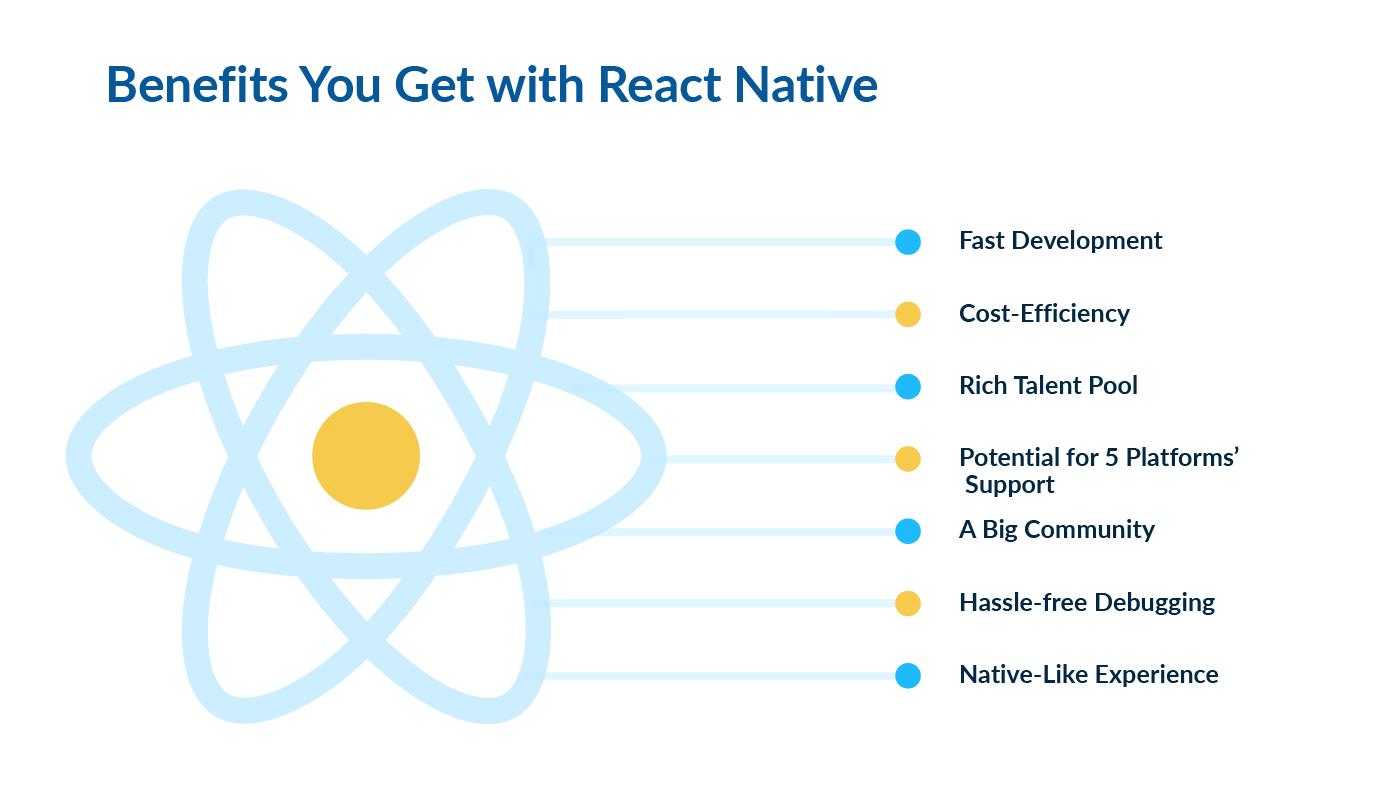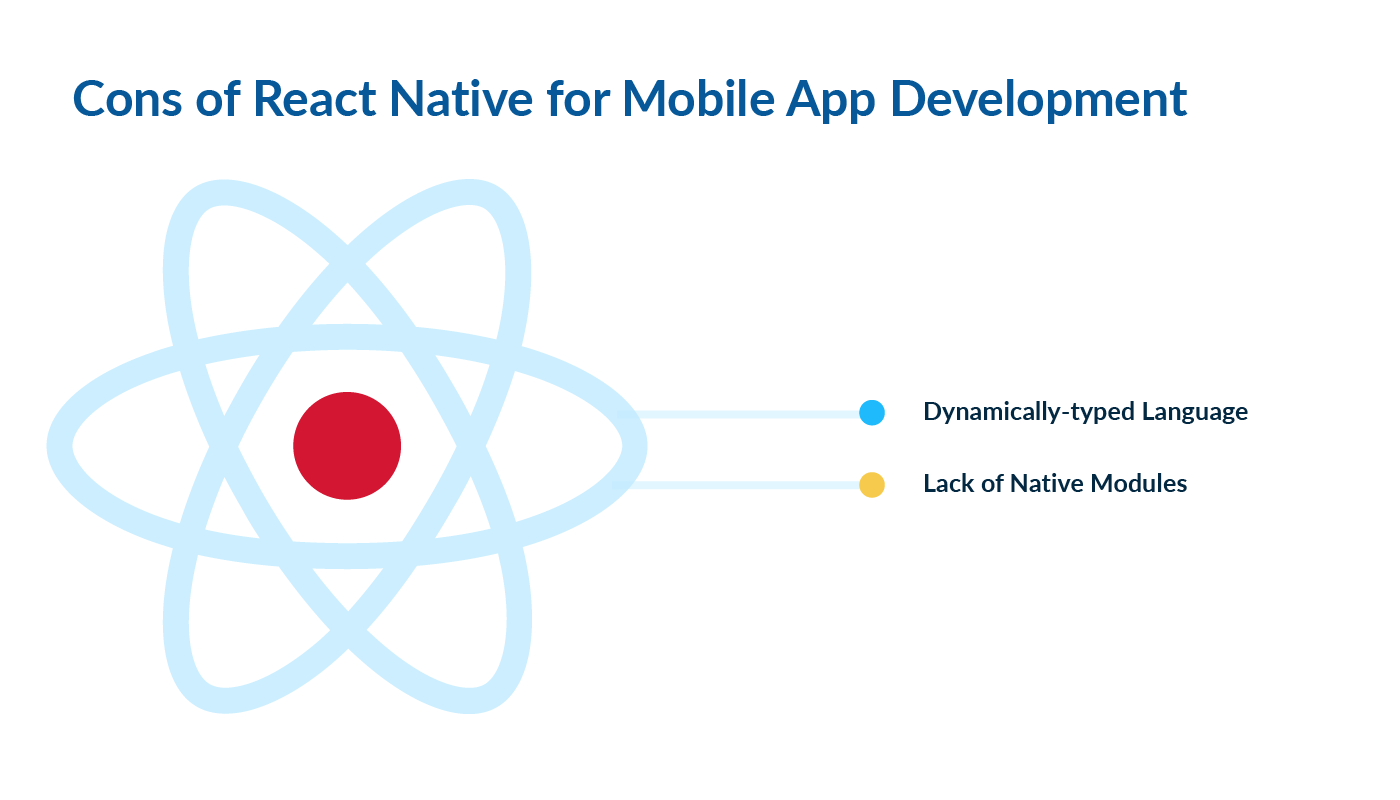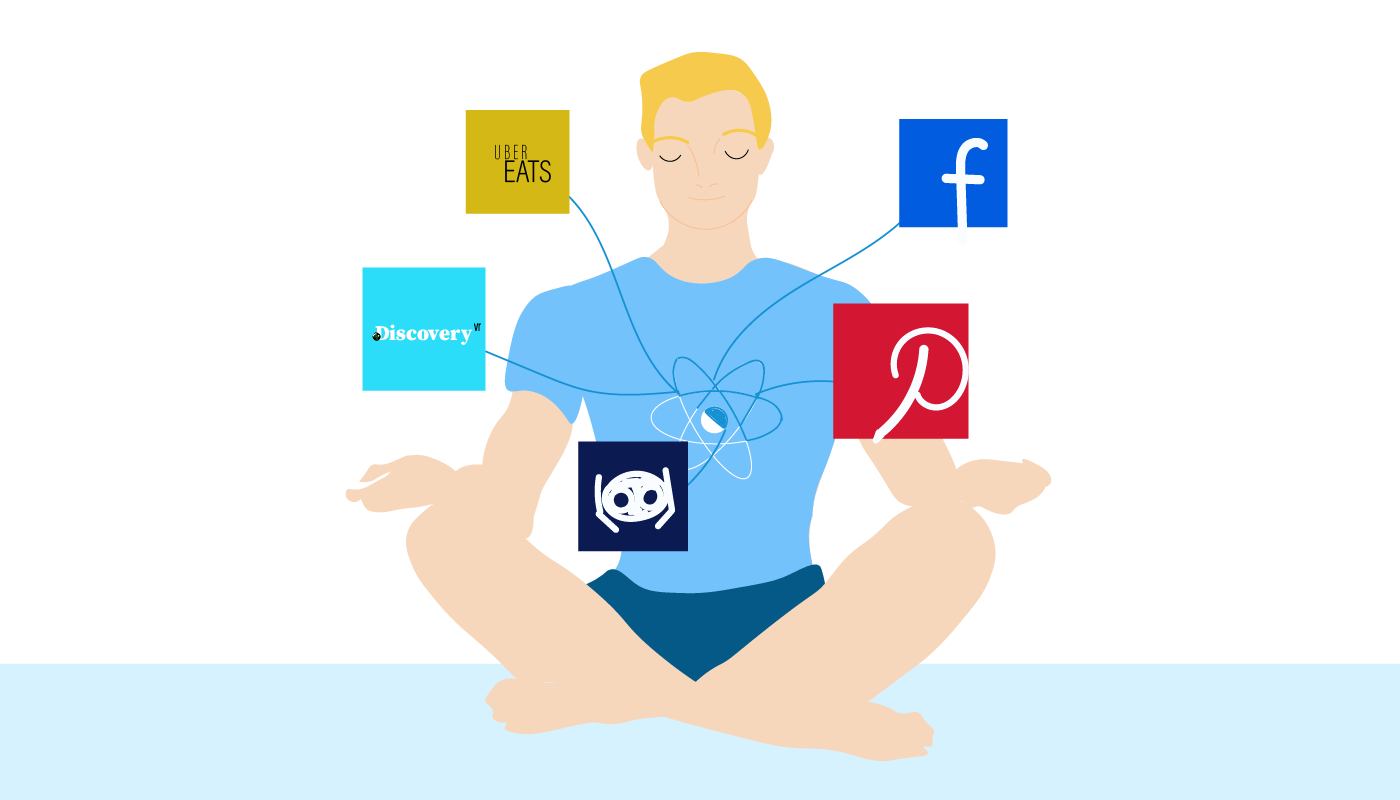For quite some time, native mobile apps have held an esteemed position as the gold standard in the realm of app development. When meticulously crafted, these apps exhibit unparalleled performance, boast visually appealing aesthetics, and offer users a plethora of platform-specific features that are simply unmatched.
Amidst this dichotomy of perspectives, the quest for truth persists: is React Native poised to herald the future of mobile development, or will native apps continue to reign supreme in the industry? In this concise exploration, we endeavor to unravel this complex question and shed light on the trajectory of mobile app development.
What’s New in the Industry?
The landscape began to shift with the emergence of cross-platform development tools, prompting numerous businesses and developers to ponder the tantalizing prospect of launching their products across multiple platforms simultaneously. The allure of this approach is undeniable – construct the app once, deploy it anywhere, and streamline maintenance efforts with a single dedicated team.
This paradigm shift sparked a fervent debate within the software engineering community and among tech industry behemoths alike: can cross-platform apps truly rival their native counterparts?
Enter React Native, one of the foremost contenders in the cross-platform mobile development arena. While proponents like Shopify sing praises of its capabilities and fully embrace React Native, dissenting voices such as Airbnb have voiced criticisms, announcing their decision to sunset React Native platforms and pivot their efforts back to native development.
What is React Native?
For those who are new to the topic, React Native is a cross-platform mobile development framework written in JavaScript. The story of its foundation goes back to the summer of 2013—Facebook’s internal hackathon. Developers could test the first release of the framework in January 2015, and since then it has been constantly evolving to provide practitioners and users with outstanding experience.
Despite being a relatively young technology, the React Native platform received wide application in a variety of industries. It has one of the fastest-growing communities on GitHub and Stack Overflow. You can also meet different groups of React Native developers on Facebook, Twitter, and various other platforms, such as Reactiflux or Reddit. With so many adopters out there, you have multiple ready-made plugins and solutions at your fingertips to build an app without a hassle.
However, along with an army of followers raving about the framework, you can find a bunch of haters on the net who won’t exchange native development for any cross-platform counterpart. As Nader Dabit once said on Twitter “React Native has more haters than Kanye. Maybe that’s why the framework and community just keeps getting stronger”.

Advantages Of React Native
Fast Development
When you have a single team to build your cross-platform product, it is easier to keep track of the process. You do not need to check up with Android or iOS developers to fix bugs or organize sync-ups, which means you can have your mobile app ready faster and be the first to launch it on the market.
Apart from synchronized development cycles, the React Native platform has one substantial advantage that differentiates the framework from its rivals — “hot reloading” function. It allows making changes to the app and reviewing their results almost immediately. Moreover, you can take advantage of “live reloading” to automate the building process and get rid of the manual work. In contrast to native development, where the process of rebuilding an app is a long-lasting burden, React Native saves your developers’ time and effort.
What is more, in React Native 0.61, the creators decided to unite the “hot reload” and “live reloading” functions and presented “fast refresh”, which appears to be a mix of both. A new update addressed the major pain points developers experienced with “hot reloading”: the function was unreliable and often failed to update the screen. Furthermore, if you have any typos or mistakes in your code, it doesn’t work. A new function copes well with typos and falls back to full reload when necessary.
Cost-Efficiency
In addition to the impressive strides React Native platforms are making in achieving a native experience, its cost-effectiveness remains a major selling point for businesses and developers alike.
Building two separate mobile apps for Android and iOS might appear to be quite a pricy venture. You need to assemble two different teams, which will be cooperating to bring your idea to market. In such a scenario, you’ll have to work with both of them to ensure your product meets the users’ expectations. By opting for a cross-platform alternative, you can cut costs without compromising on quality.
React Native’s streamlined development process, utilizing JavaScript and familiar web development tools, enables faster development cycles compared to native development.
Maintaining a single codebase for both platforms is significantly easier and less expensive than managing separate native codebases. This translates to lower long-term maintenance costs and faster bug fixes.
Rich Talent Pool
React Native platform combines the benefits of both worlds as it was created based on the best practices of native development and React, which is considered to be one of the most efficient JavaScript libraries for building user interfaces. In addition to being demanded and popular, these technologies have a mild learning curve. So, web developers when they get bored doing their job or want to upgrade their skills, often switch to React Native to work with cross-platform mobile apps. It means hiring React Native developers will be much easier for you compared to Kotlin or Swift developers.
Potential for 5 Platforms’ Support
Are you looking for the technology to build a mobile app that would be accessible to a broad audience? Then React Native might make a perfect match for you. There is a common misconception among non-tech people that the framework can only be used for Android and iOS. There is a set of community-supported projects that allow building an app that can be launched on several platforms (including Windows and MacOS). Furthermore, the framework is constantly evolving to support new platforms, which provide plenty of opportunities for businesses and developers as well.
A Big Community
When your development team is stuck with a challenge, it might take a considerable amount of time for them to find a way out. Building a solution from scratch might appear to be a resource-consuming process that may delay the launch of your product. However, a big community of React Native fans might have already had the same issue, so they may provide you with all the necessary tools to fix a problem as soon as it appears. The large React Native support makes it popular in the market.
JavaScript Engine
In 2019, Facebook presented a new open-source JavaScript engine called “Hermes” with an aim to improve the performance of React Native mobile apps on Android. With the help of static optimization and compact bytecode, it reduces the app’s size, optimizes the startup time, and enhances memory utilization. In such a way, this engine enables developers to build cross-platform applications that provide a superior native-like experience.
Hassle-free Debugging
Flipper is a convenient tool that enables developers to debug React Native mobile apps quickly and efficiently. It has already become an indispensable instrument in many companies and teams. Metro Action, Crash Reporter, React DevTools, Network, and Native Layout Inspector are just a few out of numerous features that go out of the box with this instrument. And in new React Native 0.62, it goes by default, so you don’t need to waste your precious time installing and configuring it.
Apart from this React Native platform, you might find a set of commands that allow troubleshooting and fixing errors in your development environment. In particular, Meet Doctor is a new React native command that allows developers to find issues in their code and fix them automatically. It is currently supported by most of the libraries React Native relies on, including XCode and Android SDK. This feature saves the time of your development team and ensures you get excellent code free from bugs and errors.
React Native Gets Even More Native
React Native platform has transformed the landscape of cross-platform app development, allowing developers to craft apps that feel incredibly native on both iOS and Android. However, a performance and feature gap existed compared to truly native apps.
The React Native team has been diligently working to bridge this gap, introducing features and enhancements that push the boundaries of what’s possible with cross-platform development. Here’s how React Native is embracing its native side:
Speed Demystified: React Native apps are experiencing significant performance boosts thanks to:
- Hermes: This new JavaScript engine delivers lightning-fast execution, minimizing load times and ensuring a smooth user experience.
- Fabric: This innovative architecture empowers performance optimization, and fine-tuning apps for peak efficiency.
Native Feature Fiesta: Access to native features has expanded, encompassing elements like the camera, GPS, and sensors. This allows React Native apps to seamlessly integrate platform-specific functionalities.

Disadvantages of React Native
React Native is Written in Dynamically-typed Language
JavaScript, a dynamically typed language known for its flexibility and rapid development. While this freedom fosters agility, it can also introduce potential pitfalls. Unlike statically typed languages like Swift or Kotlin, where variables and functions have defined types, JavaScript allows variables to change their type on the fly. This is a direct way to runtime issues if not managed carefully. Here are some of the disadvantages of React Native that may be related to this.
- Because dynamically-typed languages don’t enforce type checking, it’s possible for variables to hold unexpected values at runtime. This can lead to errors that are difficult to track down and debug. For example, you might expect a variable to hold a number, but it could accidentally be assigned a string instead. This can cause unexpected behavior and crashes.
- As codebases grow, it becomes more difficult to understand and maintain code that is not type-safe. Without clear type definitions, it can be challenging to know what data types are expected by different parts of the code, which can lead to bugs and errors.
- Integrated development environments (IDEs) can provide valuable assistance with code completion, refactoring, and error checking. However, this support is often limited for dynamically-typed languages, as the IDE cannot always infer the types of variables and functions.
Lack of Some Native Modules
While developing custom solutions, your team might need to insert the parts of native code into your product. In this case, you might end up having several codebases instead of a single one, which will demonstrate substantial differences in behavior and appearance. However, these are minor cases that do not often appear, so you are unlikely to face this issue.
The lack of some native modules can be a challenge for React Native developers, as it can limit the functionality of their apps. For example, if you want to build an app that uses the camera, you will need to find or create a native module that provides access to the camera.
There are a few reasons why some native modules are not available in the React Native platform:
- Complexity: Some native features are simply too complex to be exposed through JavaScript.
- Performance: In some cases, it is not possible to achieve the same level of performance with JavaScript as with native code.
Security: For security reasons, some platform features are not accessible through JavaScript.

What Lies Ahead for the React Native Platform?
2023 painted a positive picture for React Native, but with nuances to consider. Here’s a breakdown of the current market landscape:
Positives:
- Market demand: The demand for cross-platform development remains high, and React Native is a leading player. In 2022, app downloads across iOS App Store, Google Play, and third-party Android stores collectively surpassed 255 billion.”
- Community strength: The vibrant React Native community continues to be a pillar of its success. Active contributors, extensive libraries, and readily available resources solidify its support system.
- Performance advancements: Initiatives like Fabric and Hermes are delivering tangible performance improvements, narrowing the gap with native apps. Faster load times and smoother animations enhance user experience.
- Emerging trends: React Native is exploring expanding beyond mobile. Experiments with desktop and web integrations indicate potential for broader application and audience reach.
- Alignment with future tech: The focus on JavaScript aligns well with trends like WebAssembly and IoT, positioning React Native to adapt to future innovations.
Challenges:
- Native feature parity: Achieving true native performance and feature integration remains a challenge, particularly for complex functionalities.
- Security concerns: As apps handle sensitive data, robust security measures are crucial. The community needs to prioritize best practices and offer comprehensive solutions.
- Community governance: Effectively managing a large and diverse community requires clear direction and governance. Establishing efficient decision-making processes is essential.
As we enter 2024, React Native maintains its strong position in the cross-platform app development landscape. Here are some key predictions for the React Native future:
Performance and Architecture:
- Advancements in Fabric: Expect further progress on Fabric, a project focused on modularizing the core architecture. This could lead to improved performance, more flexibility, and easier maintenance.
- Bridgeless Mode and New Architecture: The “new architecture” project, while not a complete overhaul, might see its Bridgeless Mode gain traction. This mode aims to provide direct access to native APIs, potentially boosting performance and native feature integration.
- Continued Hermes adoption: The Hermes JavaScript engine will likely see wider adoption due to its significant performance gains.
Developer Experience:
- Improved tooling and libraries: Expect an increasing focus on enhancing developer experience with better tooling, more robust libraries, and streamlined workflows.
- TypeScript integration: TypeScript adoption is likely to rise, offering stronger type safety and improved code organization for larger projects.
- Focus on accessibility: Accessibility features will likely receive more attention, ensuring React Native apps cater to a wider audience and comply with regulations.
Expanding Reach and Capabilities:
- React Native for web development: Experiments with building web and desktop applications using React Native could mature, offering developers new avenues to reach broader audiences.
- Integration with emerging technologies: Expect to see continued exploration of React Native’s potential in areas like AR/VR, wearables, and the metaverse, expanding its capabilities and relevance.
Community and Governance:
- Evolving governance: The React Native community might implement improved governance structures to handle the growing number of contributors and ensure efficient decision-making.
- Focus on security: Security will remain a critical area, with the community focusing on best practices, secure coding guidelines, and potential security tools.
Competition and Challenges:
Competition from Flutter: Flutter remains a strong competitor, and React Native needs to continue innovating and improving developer experience to maintain its market share.
Native development considerations: For highly complex or performance-critical apps, native development might still be preferred by some companies.
Overall, 2024 looks promising for the React Native future. Focus on performance, developer experience, expanding reach, and strong community governance will be key to its continued success. Staying informed about these trends and actively participating in the community will equip developers to leverage the opportunities that lie ahead.
Wrapping Up
Native or cross-platform? That is the question. With the possibilities the framework delivers, skilled software engineers will be able to build an app of any complexity for your business and launch it on several platforms. React Native will provide you with a chance to reach a broader audience, cut development costs, and significantly shorten your Time to Market.
To get more info on how to turn your idea into a profitable product, use our React Native application development services and start your success journey with us!





